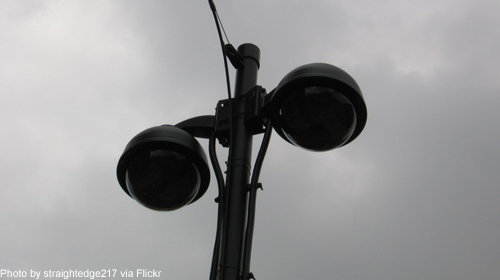
Last month, the police chief of Lincoln, Nebraska announced that the security cameras watching over the city’s downtown bar scene have not proven effective in his department’s efforts to stem criminal activity. Police Chief Jim Peschong said that the recordings hadn’t helped investigators either identify new suspects or bolster evidence against current ones. Peschong also stated that the cameras hadn’t lowered crime in their vicinity: according to Lincoln Police statistics, there were 128 assaults within 500 feet of the cameras last year, numbers that are on par with the department’s five-year average.
There are two important points to be made regarding this announcement. First, it followed a trend of government officials acknowledging the ineffectiveness of some surveillance tools. These announcements often fly under the radar, but it’s worth noting that even the greatest proponents of mass surveillance occasionally admit to its shortcomings.
The second point is that Lincoln’s police department did something that too few authorities do, which is to actually monitor and audit the performance of a surveillance technology. Every agency adopting a new surveillance technology (whether it be a camera, drone, cellphone tracking device, or anything else) should build in a process to evaluate its effectiveness. This will ensure that the agency and the public alike can understand whether they’re getting reasonable returns on both their investment and their privacy sacrifice. People might disagree over how much power we need to give to law enforcement so they can try to stop crime, but if the surveillance that they're doing isn't even effective, then there's no need for debate.
Amy Miller, the Legal Director of the ACLU of Nebraska, told me that the Lincoln Police Department approached the ACLU of Nebraska in July 2013 seeking recommendations on the installation of surveillance cameras downtown. We recommended against the cameras’ installation. We also asked if there would be “an audit scheduled for review of the cameras to determine whether they are effective or whether they should be dismantled” and who would “create the benchmarks for ‘success’ of the cameras?”
While the department went ahead in spite of our opposition, it’s clear that they took the ACLU's point about the importance of conducting evaluations to heart, and it's commendable that Chief Peschong was willing to make a statement based on information gleaned from their audit. While it’s not yet clear whether the department intends to actually remove the cameras, we hope that they will.
Between 2008 and 2011, similar evaluations of surveillance cameras’ effect on law enforcement statistics were conducted in in San Francisco, Los Angeles, Baltimore, Chicago, and Washington. Most of these reports reached the same conclusions as Lincoln’s. Only Baltimore cameras reportedly had a positive impact on the levels of crime, though the writers of that report also noted that the significant costs associated with the cameras were a deterrent to their continued use.
These evaluations outlined numerous problems caused by the cameras: they pose a heavy financial burden on police departments and cities, produce no positive effect on attempts to mitigate crime, aid practices of discriminatory targeting, and often merely displace crime to unsurveilled areas, which are often economically disadvantaged and more crime-ridden to begin with.
While it bears asking why the government is so intent on using a system that’s costly, ineffective, and adds fuel to the fire of the surveillance state, we can perhaps take some comfort in the knowledge that some officials are also keen on asking these questions. In January, the surveillance camera commissioner for England and Wales, Tony Porter, told reporters that that he regarded a majority of the 4 to 5 million video surveillance cameras in the country as useless—meaning that they failed to deter crime or help manage traffic.
Porter said that local authorities have a responsibility to inform their communities about the effectiveness of security cameras and other surveillance technologies. Such statements would of course require greater regulation and monitoring of the cameras’ utility.
While it’s significant that figures such as Peschong and Porter, who previously advocated for cameras, are now admitting to their flaws, the fact is that most cities continue to roll their security cameras in spite of the data suggesting that they’re not cost effective, and fail to apply appropriate oversight and auditing mechanisms to their surveillance technologies to see if they are even effective. We hope that more authorities will recognize that these cameras (as well as all other surveillance technologies) do not always serve a public good, and will institute regular audits to help them understand when these surveillance systems should be downsized instead of upgraded.

